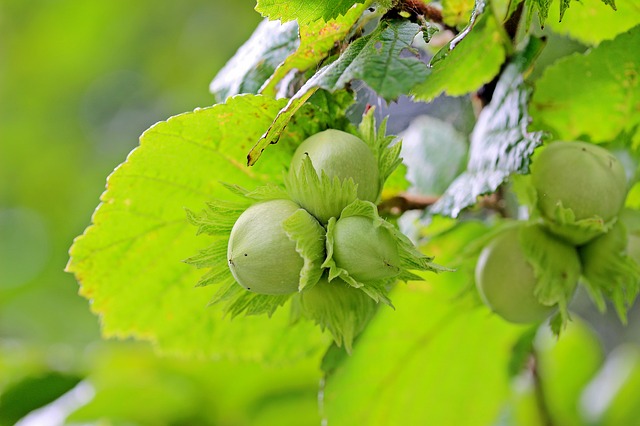
Sumergreen, 1 - 7 meter tall tree. The young branches are gray, bare, or, like the petioles, with glandular hairs. Older shoots yellow-brown, with hairs, scales and glandular hairs. Buds round or ovoid, slightly flattened from the sides, scales rounded, with hairs along the edge. The leaves on the thin branches are arranged in two rows, on the thicker ones - all around. They are darker on top, but light green on the bottom, 6 - 12 cm long, 5 - 9 cm wide. The leaf plates are round or oval, bare or with scattered hairs, the base is asymmetrically heart-shaped, the tip is pointed, the edge is unevenly double-toothed. The venation is tufted, veins with hairs. Appendices ovoid, blunt, hardly fall off early. Spikelets of male flowers up to 5 cm long, usually 2-4 in total. Male flowers without anthers, single in ovate bracts, densely covered with hairs. The bracts are two fused with the bract. The stamens are 4, divided, so it looks like 8. The anthers have a tuft of hairs at the end. Female inflorescences sessile, small, about 0.5 cm long, usually with 2 - 5 flowers, unflowered similar to leaf buds. The inflorescence is inconspicuous, gathered at the base with a seed, the edge is free. The flowers are in axils of drooping, hairy bracts. There are two bold, filamentous, purple ones. Fruit axillary bell-shaped, open at the top, irregularly split, as long or longer than the fruit. Fruit - a nut, almost round or elongated oval, brownish yellow, 1.5 - 2 cm long. Blooms in March, April, before the leaves bloom. Nuts ripen in September. about, 0.5 cm long, usually with 2-5 flowers, unflowered similar to leaf buds. The inflorescence is inconspicuous, gathered at the base with a seed, the edge is free. The flowers are in axils of drooping, hairy bracts. There are two bold, filamentous, purple ones. Fruit axillary bell-shaped, open at the top, irregularly split, as long or longer than the fruit. Fruit - a nut, almost round or elongated oval, brownish yellow, 1.5 - 2 cm long. Blooms in March, April, before the leaves bloom. Nuts ripen in September. about, 0.5 cm long, usually with 2-5 flowers, unflowered similar to leaf buds. The inflorescence is inconspicuous, gathered at the base with a seed, the edge is free. The flowers are in axils of drooping, hairy bracts. There are two bold, filamentous, purple ones. Fruit axillary bell-shaped, open at the top, irregularly split, as long or longer than the fruit. Fruit - a nut, almost round or elongated oval, brownish yellow, 1.5 - 2 cm long. Blooms in March, April, before the leaves bloom. Nuts ripen in September. as long as or longer than the fruit. Fruit - a nut, almost round or elongated oval, brownish yellow, 1.5 - 2 cm long. Blooms in March, April, before the leaves bloom. Nuts ripen in September. as long as or longer than the fruit. Fruit - a nut, almost round or elongated oval, brownish yellow, 1.5 - 2 cm long. Blooms in March, April, before the leaves bloom. Nuts ripen in September.
Practically the whole plant (roots, leaves, bark and fruits) is used for medicinal purposes. The leaves are collected while they are young - in May, the bark is collected from the young branches, in early spring or autumn. Dry on sieves, in well-ventilated areas protected from the sun. Nuts are harvested in autumn when they are fully ripe. Dry in the sun for 2 weeks or in forced dryers at 60-70C, spreading them in a thin layer and stirring occasionally. Leaves and fruits can be stored for 1 year, bark for 2 years.
Fruits (nuts) contain a large amount of substances necessary for humans - fat 62-65%; proteins 16-17%, sugar 3.5%; carbohydrates 7%; vitamins C, E, D, minerals 2% (calcium, iron, magnesium, potassium), trace elements and other biologically active substances. Nut oil contains lipotropic substances (methionine, choline, lecithin) and unsaturated fatty acids. Hazelnut bark contains essential oils, flavophenes, lignoceryl alcohol, betulin, tannins (tannins more than 8%) and dyes. The leaves contain essential oils, ascorbic and palmitic acids, and myricitroside glycoside.
Medicinal significance
The plant has astringent, anti-diarrheal, antipyretic, laxative, antiseptic, stimulating and strengthening properties. Nuts stimulate the immune system, increase the amount of milk, during the lactation period. Nuts are recommended for patients with diabetes, hypertension and atherosclerosis. They also stimulate intestinal motility well.
In folk medicine, all parts of the plant are used - nuts, leaves, buds, roots. Nuts are used as a milk-increasing and carminative agent, with its help, they dissolve kidney stones.
Hazelnuts are also used in epilepsy, gallstones, tumors and ascariasis. Medicinal creams are made from crushed nuts, which are rich in vitamins, trace elements and nutrients. It is used to restore strength after long-term illnesses, strengthens hair, reduces breakage and loss, helps treat anemia and stones in the bladder. Hazelnut powder mixed with water is used to prevent expectoration of blood, lung diseases, bronchitis, fever, kidney stones, and if added with honey, it can treat anemia and rheumatism. Nuts are also recommended for people after severe operations and infections, as well as recommended for children, as a means of promoting development and stabilizing immunity.
Hazelnut peels are used to make extracts to treat prostatitis and colitis.
A decoction of hazel leaves is used in case of adenoma and prostatic hypertrophy, and it will also be useful to treat diseases of the thyroid gland, liver and intestines, good for flatulence, avitaminosis, rickets and anemia. In addition, the leaves are also used in mixtures that prevent various problems related to metabolic processes in the body.
Bark decoctions are used for varicose veins and also to treat phlebitis.